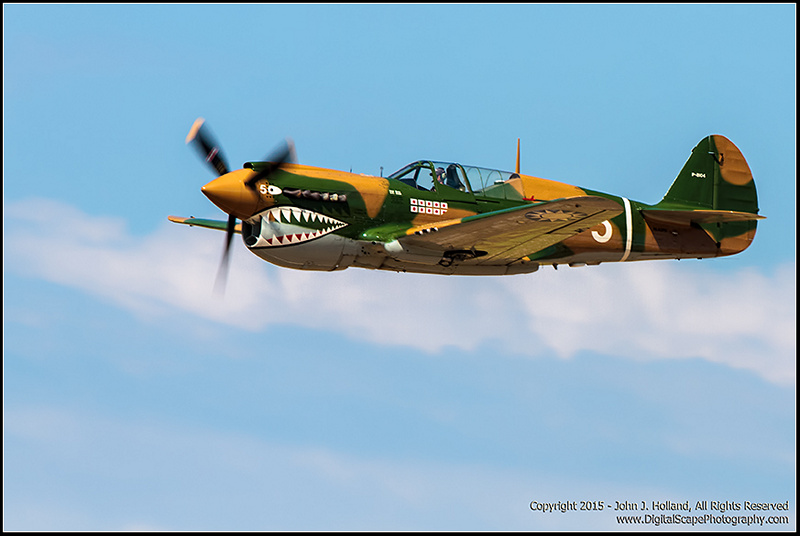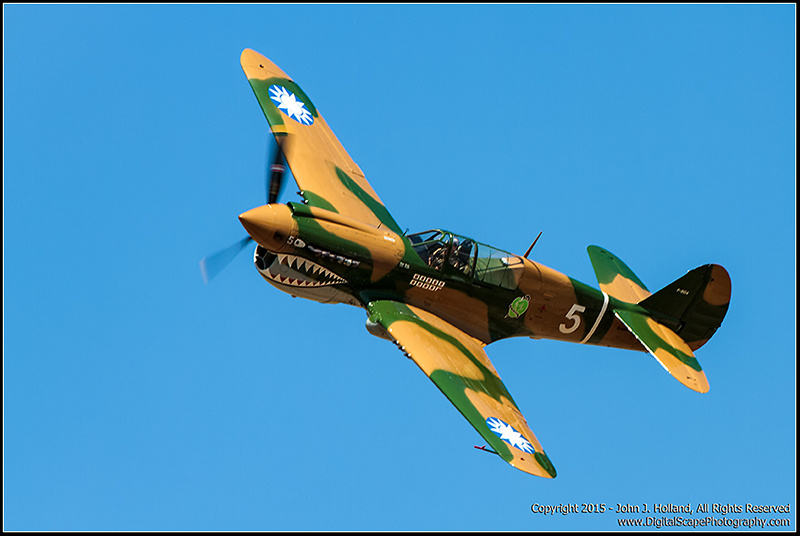Results 1 to 15 of 15
Thread: P-40 Warhawk
-
21st September 2015, 05:06 PM #1
-
21st September 2015, 06:22 PM #2
Re: P-40 Warhawk
Nice shots John,
A good choice of shutter speeds too; the first being 1/500s, the second 1/400s (for those interested).
I like the framing of both also.
Cheers, Dave
-
21st September 2015, 06:27 PM #3Moderator


- Join Date
- Feb 2009
- Location
- Glenfarg, Scotland
- Posts
- 21,402
- Real Name
- Just add 'MacKenzie'
Re: P-40 Warhawk
Agreed. Good choice of shutter speed (you did select it, yes?). Just enough blur in the prop.
-
21st September 2015, 06:50 PM #4
Re: P-40 Warhawk
+1. Excellent shooting John.

-
21st September 2015, 07:08 PM #5

- Join Date
- Dec 2013
- Location
- Turkey
- Posts
- 12,779
- Real Name
- Binnur
Re: P-40 Warhawk
Very nice shots John

-
21st September 2015, 07:26 PM #6
-
21st September 2015, 09:03 PM #7
Re: P-40 Warhawk
Thank you everyone. I appreciate your comments/feedback. Regarding the shutter, I had the camera/lens in Aperture priority, but I was watching the shutter speed as I wanted to keep it in the 400-500 range so I would get a prop blur - maybe I could have gone a bit slower.
-
21st September 2015, 09:26 PM #8
Re: P-40 Warhawk
Yeah, that's how I used to work, but the good folks here converted me to using Manual + Auto-ISO these days

I haven't shot any planes, prop or jet, since converting though.
Although in some ways, the variability of shutter speed in Aperture priority gives you more chances of getting a good result, since for some planes, the prop speed may differ for a fast or slow flypast, quite apart from differences between planes (e.g. old/new, piston/turbo-shaft, etc.), so setting a fixed shutter speed might result in all shots of a particular plane being too fast or slow. Unless we remember to choose it wisely based on a quick LCD review on the first pass.
-
21st September 2015, 10:33 PM #9
-
22nd September 2015, 12:13 AM #10
Re: P-40 Warhawk
Lovely captures...
I have not heard of the nickname "Tiger Shark" I was under the impression that the P-40 aircraft flown by the U.K. were called Kittyhawk or Tomahawk and that U.S. flown P-40 aircraft were called "Warhawk". The shark-teeth bedecked Warhawks flown for China by the American Volunteer Group (AVG or Flying Tigers) were P-40B models purchased by the U.K. who did not want them. They were turned over to Nationalist China and the AVG flying under Claire Chennault.
I had the great honor to be the guest of Commander Rutledge Irvine, USN, Retired, for dinner at the Brooklyn Navy Yard Officer's Club when I was just a young fellow. Commander Irvine was a retired Navy aviator who had flown as a member of the Flying Tigers. That is one meal I will remember for my entire life.
http://www.danfordbooks.com/tigers/toogood1.htm
Commander Irvine was living history! It was amazing to hear him relate how the Flying Tigers used their P-40B aircraft to combat the superior Japanese Zero fighter through the use of tactics which maximized the Warhawk's capabilities and minimized its bad points.
https://www.youtube.com/watch?v=22MIzNXDAIYLast edited by rpcrowe; 22nd September 2015 at 12:30 AM.
-
22nd September 2015, 03:23 AM #11
Re: P-40 Warhawk
Thank you Jim and Richard.
Wow Richard, What an honor it had to be to have dinner with Commander Irvine. thank you for the info links.
-
22nd September 2015, 04:16 AM #12
Re: P-40 Warhawk
My mother was a friend of his wife. I pressed Commander Irvine for his stories of the AVG. He also came in Second Place at the Schneider Cup Air Races in 1923. He was more willing to talk about those races but, as a young man, I was much more interested in the Flying Tigers.
As a Navy Photographer later in my life, I met many men who contributed significantly to Naval Aviation. One was John Thatch who developed a maneuver called "The Thatch Weave" which allowed U.S. Navy aviators in the Grumman Wildcat fighter to match the faster and more maneuverable Japanese Zero.
https://en.wikipedia.org/wiki/Thach_Weave
I also met Eugene Valencia who is unique in that he, as a Navy carrier aviator ace in WW-II, shot down six Japanese planes in one day. Another thing that made Eugene Valencia unique is that his Squadron Fighting Nine was aboard USS Essex supporting the North African Landings. During this deployment, Commander Valencia shot down planes from the three of our enemies opposing the North African campaign: German, Italian and Vichy French. As far as I know there was only one other aviator (from the Army Air Corps) who scored against Japan, Germany, Italy and Vichy France!
https://en.wikipedia.org/wiki/Eugene_A._Valencia,_Jr.
Before this seems like ancient history, It was about 1955 that I met Commander Irvine. That's only 10 years after WW-2 ended and four years after Pearl Harbor. Speaking about Pearl Harbor, in 1963, I interviewed the Navy Photographer's Mate who shot many (if not most) of the definitive pictures of the Pearl Harbor attack. He shot the images from Ford Island located in Pearl Harbor.
The guys who had been in combat awed me. I guess that was the same in the late 1980's, when I returned as Assistant Operations Officer of the Navy Combat Camera Group. I had spent a total of 26 months in Vietnam from 1966 to 1970. When I returned for my second tour with the Combat Camera Group, I was the only guy in that command who had actually seen combat as a photographer. I feel good that I could use my combat experience to train men who later deployed to Afghanistan and Iraq.Last edited by rpcrowe; 22nd September 2015 at 04:43 AM.
-
22nd September 2015, 01:00 PM #13
Re: P-40 Warhawk
What an interesting and amazing life you have had, Richard. And thank you for your service to our country.
-
22nd September 2015, 03:29 PM #14

- Join Date
- Jan 2015
- Location
- Kingsville, Texas
- Posts
- 877
- Real Name
- Dean
Re: P-40 Warhawk
Beautifully captured. Many years ago I worked with a man who flew with the Flying Tigers, he would have appreciated photos such as these.
-
22nd September 2015, 05:47 PM #15
Re: P-40 Warhawk
Thank you... I have been lucky that I had a lot of interesting assignments during my 32 years of Naval Service.
Some times, I don't think about them until I am reminded of them.
Probably one of the most interesting assignments was filming interviews for the film: " Hook Down, Wheels Down - The Story Of The United States Navy's Aircraft Carriers"
https://www.youtube.com/watch?v=1I6XJCEi-GU
My crew and I traveled the West Coast and filmed interviews with many of the famous and not so famous Naval Aviators (BTW: The Navy calls them "Aviators" because in Navy terminology, a "Pilot" is the person who steers a ship into a port).
I filmed one Naval Aviator who had his Navy Wings in the two digit numbers. Navy, gives sequential numbers to Aviators as the wings are awarded. This man (unfortunately I don't remember his name and they didn't use the interview for the film) was one of the first 99 Naval Aviators. He flew Wright Brothers and Curtiss Biplanes. I asked him about training in those days, the grizzled old sea-dog smiled replied, "Training hell, when I had four hours in the air, they gave me my wings. When I had twelve, they made me an instructor."
That assignment started me on a lifelong interest in the Naval and military history...

 Helpful Posts:
Helpful Posts: 


 Reply With Quote
Reply With Quote
